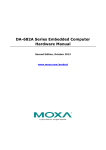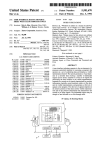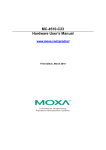Download DA-682 Hardware User`s Manual v3
Transcript
DA-682 Series Embedded Computer Hardware User’s Manual Third Edition, January 2010 www.moxa.com/product 2010 Moxa Inc. All rights reserved. Reproduction without permission is prohibited. DA-682 Series Embedded Computer Hardware User’s Manual Any software described in this manual is furnished under a license agreement and may be used only in accordance with the terms of that agreement. Copyright Notice Copyright 2010 Moxa Inc. All rights reserved. Reproduction without permission is prohibited. Trademarks MOXA is a registered trademark of Moxa Inc. All other trademarks or registered marks in this manual belong to their respective manufacturers. Disclaimer Information in this document is subject to change without notice and does not represent a commitment on the part of Moxa. Moxa provides this document “as is,” without warranty of any kind, either expressed or implied, including, but not limited to, its particular purpose. Moxa reserves the right to make improvements and/or changes to this manual, or to the products and/or the programs described in this manual, at any time. Information provided in this manual is intended to be accurate and reliable. However, Moxa assumes no responsibility for its use, or for any infringements on the rights of third parties that may result from its use. This product might include unintentional technical or typographical errors. Changes are periodically made to the information herein to correct such errors, and these changes are incorporated into new editions of the publication. Technical Support Contact Information www.moxa.com/support Moxa Americas: Toll-free: 1-888-669-2872 Tel: +1-714-528-6777 Fax: +1-714-528-6778 Moxa China (Shanghai office): Toll-free: 800-820-5036 Tel: +86-21-5258-9955 Fax: +86-10-6872-3958 Moxa Europe: Tel: +49-89-3 70 03 99-0 Fax: +49-89-3 70 03 99-99 Moxa Asia-Pacific: Tel: +886-2-8919-1230 Fax: +886-2-8919-1231 Table of Contents Chapter 1 Introduction ................................................................................................1-1 Overview.................................................................................................................................. 1-2 Model Descriptions and Package Checklist ............................................................................. 1-2 Appearance .............................................................................................................................. 1-3 Dimensions .............................................................................................................................. 1-4 Features .................................................................................................................................... 1-4 Hardware Block Diagram ........................................................................................................ 1-5 DA-682 Basic System ................................................................................................ 1-5 DA-SP08-I-DB Serial Port Expansion Module .......................................................... 1-6 DA-LN04-RJ LAN Port Expansion Module .............................................................. 1-6 Hardware Specifications .......................................................................................................... 1-7 Basic Systems ............................................................................................................. 1-7 Serial Port Expansion Modules .................................................................................. 1-9 LAN Port Expansion Module ................................................................................... 1-10 Switch Port Expansion Module ................................................................................ 1-10 Universal PCI Slot .................................................................................................... 1-10 Non-standard Baudrates ......................................................................................................... 1-10 Chapter 2 Hardware Installation .................................................................................2-1 Placement Options ................................................................................................................... 2-2 Desktop....................................................................................................................... 2-2 Rack mounting ........................................................................................................... 2-2 Wiring Requirements ............................................................................................................... 2-5 Connecting the Power .............................................................................................................. 2-6 Reset Button............................................................................................................................. 2-7 Front Panel LED ...................................................................................................................... 2-7 Connecting to a Display ........................................................................................................... 2-8 Connecting a PS/2 Keyboard and Mouse................................................................................. 2-8 Connecting USB Devices ........................................................................................................ 2-9 Gigabit LAN Ports ................................................................................................................. 2-10 Upgrading the Memory Module .............................................................................................2-11 Installing a CompactFlash Card ............................................................................................. 2-14 Installing a SATA Hard Disk .................................................................................................. 2-17 Inserting and Removing Expansion Modules ........................................................................ 2-19 DA-SP08-I-DB/DA-SP08-DB Serial Expansion Modules .................................................... 2-20 DA-SP08-I-TB Serial Expansion Module ............................................................................. 2-21 DA-LN04-RJ LAN Expansion Module ................................................................................. 2-21 Chapter 3 BIOS Setup..................................................................................................3-1 Entering the BIOS Setup Utility .............................................................................................. 3-2 Modifying the BIOS Main Settings ......................................................................................... 3-2 Basic Configuration .................................................................................................... 3-2 System Security .......................................................................................................... 3-3 Advanced Settings ................................................................................................................... 3-4 Hard Disk Boot Priority.............................................................................................. 3-4 Advanced BIOS Features ........................................................................................... 3-5 CPU Features .............................................................................................................. 3-5 Advanced Chipset Settings ......................................................................................... 3-7 PnP/PCI Configurations ............................................................................................. 3-8 Frequency/Voltage Control ........................................................................................ 3-9 Peripherals ............................................................................................................................... 3-9 OnChip IDE Device ................................................................................................. 3-10 Onboard Device ........................................................................................................ 3-11 Onboard GigaLan Control ........................................................................................ 3-12 Onboard I/O Chip Setup ........................................................................................... 3-12 Power ..................................................................................................................................... 3-13 Wake Up Control...................................................................................................... 3-14 Hardware Monitor.................................................................................................................. 3-15 Load Defaults ......................................................................................................................... 3-15 Exiting the BIOS Setup .......................................................................................................... 3-16 Upgrading the BIOS .............................................................................................................. 3-17 Appendix A Safety Installation Instructions ................................................................. A-1 1 Chapter 1 Introduction Thank you for purchasing a Moxa DA-682 Series X86-based industrial ready-to-run embedded computer. The DA-682 computers come pre-installed with one of three embedded operating systems: • • • DA-682-CE: Windows CE 6.0 DA-682-LX: Linux DA-682-XPE: Windows XP Embedded This manual introduces the hardware installation, connector interfaces and BIOS setup of the DA-682. For software configuration and management, please refer to the user’s manual for your operating system. This chapter covers the following topics: Overview Model Descriptions and Package Checklist Appearance Dimensions Features Hardware Block Diagram DA-682 Basic System DA-SP08-I-DB Serial Port Expansion Module DA-LN04-RJ LAN Port Expansion Module Hardware Specifications Basic System Serial Port Expansion Module Switch Port Expansion Module LAN Port Expansion Module Non-standard Baudrates DA-682 Series Hardware User’s Manual Introduction Overview The Moxa DA-682 Series of X86-based rackmount embedded computers are designed for industrial data acquisition applications. The state-of-art 2 expansion module design provides greater flexibility by allowing combinations of up to 16 RS-232/422/485 serial ports or up to 4+8 Ethernet ports. This friendly design gives users the advantage of being able to swap out modules quickly and easily. Additional expansion modules will be available soon to provide even greater flexibility. The DA-682’s main operating system is based on the Intel Celeron M processor and 915GME chipset, which supports standard X86 VGA, USB, PS/2 keyboard/mouse, 4 Gigabit LAN ports, and IDE/SATA disk interface. In addition, the DA-682 has a CompactFlash socket and comes with Linux, WinCE 6.0, Windows XP Embedded pre-installed. Programmers will find the full-function development kit a great benefit for developing software and building reliable communication applications. The housing is a standard 2U, 19-inch wide rack-mounted rugged enclosure. This robust, rack-mountable design provides the hardened protection needed for industrial environment applications. Model Descriptions and Package Checklist The DA-682 Series includes the following models: DA-682-CE DA-682 basic system, VGA, 4 Gigabit LANs, USB x 4, CompactFlash socket, 256 MB system memory, 256 MB WinCE 6.0 pre-installed flash disk module DA-682-LX DA-682 basic system, VGA, 4 Gigabit LANs, USB x 4, CompactFlash socket, 512 MB system memory, 1 GB Linux pre-installed flash disk module DA-682-XPE DA-682 basic system, VGA, 4 Gigabit LANs, USB x 4, CompactFlash socket, 512 MB system memory, 1 GB Windows XPE pre-installed flash disk module. Each model is shipped with following standard items: DA-682 Basic System: Quick Installation Guide Document & Software CD Cross-over Ethernet cable AC Power Cord Product Warranty Statement Optional Expansion Modules: DA-SP08-I-DB: 8-port RS-232/422/485 serial port module with isolation protection, DB9 connectors DA-SP08-DB: 8-port RS-232/422/485 serial port module, DB9 connectors DA-SP08-I-TB: 8-port RS-232/422/485 serial port module with isolation protection, terminal block connector DA-LN04-RJ: 4-port 10/100 Mbps LAN module. DA-UPCI-DK: 5V standard PCI extension kit 1-2 DA-682 Series Hardware User’s Manual Introduction ATTENTION Additional expansion modules are currently under development. Appearance Front View Rear View ATTENTION Expansion modules can be installed in either slot A or slot B. In the above figures we shown an example of LAN module DA-LN04-RJ installed in slot A and serial module DA-SP08-I-DB installed in slot B. 1-3 DA-682 Series Hardware User’s Manual Introduction Dimensions Features The DA-682 Basic System has the following features: Intel Celeron M 1GHz processor with 400/533 MHz FSB Intel 915GME + ICH6M chipset 200-pin DDR2 SODIMM socket x1, supporting DDR2 400/533 up to 1 GB 4 Gigabit Ethernet ports for network redundancy 1 CompactFlash socket 1 SATA connector for storage expansion USB 2.0 ports for high speed peripherals 2 expansion module slots for I/O expansion 19-inch rackmount, 2U height form factor Fanless design 100/240 VAC/VDC power inputs Ready-to-run Linux, WinCE 6.0, or Windows XP Embedded platform pre-installed on the flash disk module 1-4 DA-682 Series Hardware User’s Manual Introduction Features supported by expansion modules: 8 or 16 software selectable RS-232/422/485 serial ports, with or without isolation protection Serial port baudrates from 50 to 921.6 Kbps, with support for most non-standard baudrates in this range Additional 4 or 8 10/100 Mbps Ethernet ports ATTENTION Refer to the “Non-standard Baudrates” section for instructions on how to calculate which baudrates are supported. Hardware Block Diagram DA-682 Basic System VGA LAN1 Intel Celeron M 1GHz CPU LAN2 Gigabit LAN Ports Power RTC Watch Dog LAN3 LAN4 DDR2 SODIMM Intel 915 GME North Bridge USB1 Flash DOM USB2 Intel ICH6 South Bridge USB3 CF Socket USB4 SATA Expansion Module A Expansion Module B RS-232/422/485 Serial Ports or 10/100 Mbps LAN Ports 1-5 BIOS Supe r I/O PS/2 KB/Mouse DA-682 Series Hardware User’s Manual Introduction DA-SP08-I-DB Serial Port Expansion Module PCI Bus to DA-682 Basic System Moxa UART ASIC I1 I2 I3 I4 I5 I6 I7 I8 Isolation Circuit P1 P2 P3 P4 P5 P6 P7 P8 DB9 Connector RS-232/422/485 DA-LN04-RJ LAN Port Expansion Module PCI Bus to DA-682 Basic System PCI Bridge Realtek RTL8100 LAN1 Realtek RTL8100 LAN2 Realtek RTL8100 LAN3 10/100 Mbps LAN Ports 1-6 Realtek RTL8100 LAN4 RJ45 Connector DA-682 Series Hardware User’s Manual Introduction Hardware Specifications DA-682 series embedded computers support peripheral expansion through two expansion slots located on the DA-682 Basic System. Basic Systems DA-682-CE DA-682-LX Computer CPU Intel Celeron M 1 GHz processor OS (pre-installed) WinCE 6.0 System Chipset Intel 915GME + ICH6M chipset FSB Linux 2.6 DA-682-XPE Windows XP Embedded SP2 400/533 MHz Expansion Bus Two PCI expansion slots (one slot reserved for additional peripherals) BIOS 4 mega-bit Flash BIOS, PCI Plug & Play, ACPI function support System Memory 1 x 200-pin DDR2 SODIMM socket supporting DDR2 400/533 (256 MB max.) CompactFlash Socket available for storage expansion with DMA mode support Other Peripherals USB KB/MS Display Graphics Controller 1 x 200-pin DDR2 SODIMM socket supporting DDR2 400/533 (1 GB max.) 1 x 200-pin DDR2 SODIMM socket supporting DDR2 400/533 (512 MB max.) USB 2.0 compliant hosts x 4, Type A connector, supports system boot up 1 PS/2 interface, support standard PS/2 keyboard and PS/2 mouse via Y-type cable (0ptional) Integrated graphics with built-in Intel 915GME, and built-in Intel extreme Graphics 2 technology Display Memory Dynamic video memory (shares up to 32 MB of system memory) Display Interface CRT Interface for VGA output (DB15 female connector) Resolution CRT display mode with pixel resolution up to 2548 x 1536 at 75Hz Ethernet Interface LAN Magnetic Isolation Protection Auto-sensing 10/100/1000 Mbps Gigabit Ethernet x 4, using Realtek RTL8110SC Controller 1.5 KV built-in Serial Interface Number of Ports 8 Serial Standards RS-232/422/485 Connectors DB9 male ESD protection 15 KV for all signals Optical Isolation Protection 2 KV 1-7 DA-682 Series Hardware User’s Manual Introduction Serial Communication Parameters Data Bits 5, 6, 7, 8 Stop Bits 1, 1.5, 2 Parity None, Even, Odd, Space, Mark Flow Control RTS/CTS, XON/XOFF, ADDC™ (automatic data direction control) for RS-485 Baudrate 50 bps to 921.6 Kbps (non-standard baudrates supported; see user's manual for details) Serial Signals RS-232 TxD, RxD, DTR, DSR, RTS, CTS, DCD, GND RS-422 TxD+, TxD-, RxD+, RxD-, GND RS-485-4w TxD+, TxD-, RxD+, RxD-, GND RS-485-2w Data+, Data-, GND LEDs Sytem Ready x 1, Storage x 1 LAN Act/Link x 8, 10/100M mode x 8 Serial TX/RX x 8 Physical Characteristics Enclosure SECC sheet metal (1 mm) Weight 2.94 kg Dimensions 440 x 310 x 90 mm (17.32 x 12.2 x 3.54 in) Mounting Standard 19-inch rackmount Switches and Buttons Power Switch on/off (on rear panel) Reset Button To reset system hardware (on front panel) Environmental Limits Operating Temperature -10 to 60°C (14 to 140°F) Operating Humidity 5 to 95% RH Storage Temperature Standard Models: -20 to 80°C (-4 to 176°F) Anti-Vibration 2 g rms @ IEC-68-2-34, random wave, 5-500 Hz, 1 hr/axis Anti-Shock 20 g @ IEC-68-2-27, half sine wave, 11 ms Power Requirements Input Voltage 100 to 240 VAC auto-ranging (47 to 63 Hz for AC input) , VDC model available on request Power Consumption 50W Input Rating 100-240VAC, 47-63Hz, 1.0A-0.5A Regulatory Approvals EMC Safety CE (EN55022 Class A, EN61000-3-2 Class A, EN61000-3-3, EN55024), FCC (Part 15 Subpart B, CISPR 22 Class A), CCC (GB9254, GB 17625.1) UL/cUL (UL60950-1, CSA C22.2 No. 60950-1-03), LVD (EN60950-1), CCC (GB4943) 1-8 DA-682 Series Hardware User’s Manual Reliability Alert Tools Introduction Built-in buzzer and RTC (real-time clock) with battery lithium backup Automatic Reboot Trigger Built-in WDT (watchdog timer) supporting 1-255 level time interval system reset, software programmable Warranty Warranty Period 3 years Details See www.moxa.com/warranty Serial Port Expansion Modules DA-SP08-I-DB DA-SP08-DB DA-SP08-I-TB DA-SP38-I-TB Serial Interface Number of Ports RS-232/422/485 x 8 RS-422/485 x 8 Serial Standards RS-232/422/485, software-selectable RS-422/485 Connector Protection DB9 male DB9 male 15 KV ESD and 15 KV ESD 2 KV isolation protection for all signals protection for all signals 5-pin terminal block 15 KV ESD and 2 KV isolation protection for all signals 15 KV ESD and 2 KV isolation protection for all signals Serial Signals RS-232 TxD, RxD, DTR, DSR, RTS, CTS, DCD, GND RS-422 TxD+, TxD-, RxD+, RxD-, GND RS-485 4-wire TxD+, TxD-, RxD+, RxD-, GND RS-485 2-wire Data+, Data-, GND Data bits 5, 6, 7, 8 Stop bits 1, 1.5, 2 Parity None, Even, Odd, Space, Mark Flow Control RTS/CTS, XON/XOFF, RS-485 ADDCTM N/A ATTENTION Refer to the “Non-standard Baudrates” section for instructions on how to calculate which baudrates are supported. 1-9 DA-682 Series Hardware User’s Manual Introduction LAN Port Expansion Module LAN Port DA-LN04-RJ Auto-sensing 10/100 Mbps x 4 Connector RJ45 connector Protection 1.5 KV magnetic isolation protection Switch Port Expansion Module Switch Port Connector Protection DA-SW08-RJ Auto-sensing unmanaged 10/100 Mbps x 8 RJ45 connector 1.5 KV magnetic isolation protection Universal PCI Slot Fit-in System DA-UPCI-DK DA-682 Series PCI Slot 1 Interface Bus 32-bit Universal PCI (3.3V and 5V) Non-standard Baudrates Moxa’s UART ASIC, which is used for both the DA-SP08-I-DB and DA-SP08-I-TB serial expansion modules, supports most non-standard baudrates in the range 50 bps to 921.6 Kbps. In fact, supported baudrates are much denser towards the lower values. For example, no baudrates are supported between the integers 5320 and 5323, but 49 baudrates are supported between the integers 387 and 388. Of course this is the way it should be, since serial devices that require using non-standard baudrates generally use slower baudrates. Before using a serial device that requires using a non-standard baudrate, you must first check that the DA-682 supports a baudrate within the tolerance specified by the serial device manufacturer. Use the following formula to calculate which baudrates are supported by the DA-283: (A) Baudrate = 921600/(N+M/8) bps, for N = 1, 2, …, 18431, M = 0, 1, 2, …, 7 or (B) Baudrate = 8 x 921600/K bps, for K = 8, 9, …, 147456 If you are a programmer and you need to write a driver for your serial device, then you may need to use formula A. If you have a serial device that requires using a non-standard baudrate, then you can use formula B to determine if the DA-682 supports a baudrate within the tolerance specified by the serial device manufacturer. Example: Your serial device requires using a baudrate of 5340 bps and has a tolerance of 2 bps. Can the DA-682 be used with this device? Solution: Set formula B to the desired baudrate and then solve for K. 8 x 912600/K = 5338 ==> K = 1367.703259… 1-10 DA-682 Series Hardware User’s Manual Introduction This shows that the supported baudrate closest to 5340 comes from setting K=1367 or K=1368. K=1368 ==> Baudrate1 = 5336.842105... K=1367 ==> Baudrate2 = 5340.746159… Since 5338 – Baudrate1 < 2, we can see that the DA-682 supports the serial device. Note that we can use formula A to generate the so-called “standard” baudrates, which come from setting M=0, and setting N equal to certain integers. Standard Baudrates Baudrate N M Baudrate N M 921600 1 0 4800 192 0 460800 2 0 2400 384 0 230400 4 0 1800 512 0 115200 8 0 1200 768 0 57600 16 0 600 1536 0 38400 24 0 300 3072 0 19200 48 0 150 6144 0 9600 96 0 75 12288 0 7200 128 0 50 18432 0 WARNING Communication between a serial device and a Moxa UART port may not work correctly if the serial device uses a baudrate that it not within the correct tolerance of a baudrate calculated from either formula A or formula B. 1-11 2 Chapter 2 Hardware Installation The DA-682 Series of embedded computers are compact and rugged, making them suitable for industrial applications. The LED indicators allow users to monitor performance and identify trouble spots quickly, and multiple ports are provided for connecting a variety of different devices. The DA-682 embedded computers come with a reliable and stable hardware platform that lets you devote the bulk of your time to application development. This chapter describes hardware installation and connector interfaces of the DA-682 embedded computers. This chapter covers the following topics: Placement Options Desktop Rack mounting Wiring Requirements Connecting the Power Reset Button Front Panel LED Connecting to a Display Connecting a PS/2 Keyboard and Mouse Connecting USB Devices Gigabit LAN Ports Upgrading the Memory Module Installing a CompactFlash Card Installing a SATA Hard Disk Error! Reference source not found. DA-SP08-I-DB/DA-SP08-DB Serial Expansion Modules DA-SP08-I-TB Serial Expansion Module DA-LN04-RJ LAN Expansion Module DA-682 Series Hardware User’s Manual Hardware Installation Placement Options Desktop Place your DA-682 on a clean, flat, well-ventilated desktop. For better ventilation, leave some space between the DA-682 and other equipment. Do not place equipment or objects on top of the DA-682, as this might damage the computer’s internal components. Rack mounting The DA-682 has rackmount supports for installing the embedded computer on a standard rack. ATTENTIONS 1. 2. For maximum safety, at least two persons should work together to lift, place, and attach the embedded computer to the rack. Before you lift or move the embedded computer, make sure that the embedded computer is turned off and the power to the rack system is turned off. Four rackmount screws are required to attach the DA-682 to a standard rack. Follow these steps to install the DA-682 on a rack. Step 1: Installing the rackmount supports. Take the rackmount supports out of the packages. There are two packages, each of which contains 1 rackmount support, 1 rackmount hanger, 2 FMSM5X10 screws, and 6 FMSM4X6 screws. 2-2 DA-682 Series Hardware User’s Manual Hardware Installation Rackmount hanger Rackmount support FMSM4X6 screws FMSM5X10 screws Step 2: Installing rackmount hanger to the support. Use 2 FMSM5X10 screws to attach the rackmount hanger to the ear. Repeat this procedure for the additional support and hanger. 2-3 DA-682 Series Hardware User’s Manual Step 3: Hardware Installation Installing the rackmount ears to the DA-682. Use 6 FMSM4X6 screws to attach one rackmount support to one side of the DA-682. Repeat this procedure for the additional support+hanger. Step 4: Installing the DA-682 to a rack. Gently slide the DA-682 onto the rack, and then use screws provided by the rack supplier to fix the rackmount support to the rail. Note that four screws are required to attach the DA-682 to the rack. Use two screws on the left side and two screws on the right side. 2-4 DA-682 Series Hardware User’s Manual Hardware Installation As a final check, make sure that the four screws are firmly attached to the rack. screws screws Wiring Requirements The following common safety precautions should be observed before installing any electronic device: Use separate paths to route wiring for power and devices. If power wiring and device wiring paths must cross, make sure the wires are perpendicular at the intersection point. You can use the type of signal transmitted through a wire to determine which wires should be kept separate. The rule of thumb is that wiring that shares similar electrical characteristics can be bundled together. Keep input wiring and output wiring separate. When necessary, it is strongly advised that you label wiring to all devices in the system. ATTENTION Do not run signal or communication wiring and power wiring in the same wire conduit. To avoid interference, wires with different signal characteristics should be routed separately. 2-5 DA-682 Series Hardware User’s Manual Hardware Installation ATTENTION Safety First! Be sure to disconnect the power cord before installing and/or wiring your device. Electrical Current Caution! Calculate the maximum possible current in each power wire and common wire. Observe all electrical codes dictating the maximum current allowable for each wire size. If the current goes above the maximum ratings, the wiring could overheat, causing serious damage to your equipment. Temperature Caution! Be careful when handling the unit. When the unit is plugged in, the internal components generate heat, and consequently the outer casing may feel hot to the touch. Connecting the Power To power on the DA-682 embedded computer, connect the power line to the DA-682’s AC power connector (located on the right side of the rear panel) using the power cord shipped with the product, and then turn on the power switch. If the power is properly supplied, the Power LED will light up first, and then the Storage LED will start blinking when the Flash Disk Module is accessed during boot up. It takes about 30 to 60 seconds for the operating system to boot up. 2-6 DA-682 Series Hardware User’s Manual Hardware Installation Reset Button Pressing the Reset button initiates a hardware warm reboot. The button plays the same role as a desktop PC’s reset button. After pressing the reset button, the system will reboot automatically. During normal use, you should NOT use the Reset Button. You should only use this button if the software is not working properly. To protect the integrity of data being transmitted or processed, you should always reset the system from the operating system with the software reboot function. Front Panel LED There are 40 LED indicators on the front panel. Information about each LED is given in the following table. LED Power Storage Gigabit LAN LEDs 1-4 Color Green Off Orange/Blinking Off Green Orange Off Green Module A LEDs 1-8 Orange Off Green Module B LED 1-8 Orange Off Description Power is on No power input or power error exists Data is being written to or to read from the storage unit Storage unit is idle 100 Mbps Ethernet mode 1000 Mbps (Gigabit) Ethernet mode No operation or 10 Mbps Ethernet mode 100 Mbps Ethernet mode or TX signal of serial port is active. 10 Mbps Ethernet mode or RX signal of serial port is active. No operation 100 Mbps Ethernet mode or TX signal of serial port is active. 10 Mbps Ethernet mode or RX signal of serial port is active. No operation 2-7 DA-682 Series Hardware User’s Manual Hardware Installation Connecting to a Display Your DA-682 embedded computer comes with a D-Sub 15-pin female connector to connect to the VGA monitor. Be sure to remove the power before you connect or disconnect the monitor cable. Pin No. 1 2 3 4 5 6 7 8 9 10 11 12 13 14 15 Signal Definition RED GREEN BLUE --GND CRT_DETECT# GND GND +5V GND --DDC_DATA HSYNC VSYNC --- Connecting a PS/2 Keyboard and Mouse Your DA-682 embedded computer comes with a PS/2 mini-DIN connector to connect to a PS/2 keyboard and PS/2 mouse. This 6-pin mini-DIN connector has the pin assignments shown below. Pin No. 1 2 3 4 5 6 Signal Definition PS/2 Keyboard Data PS/2 Mouse Data GND VCC PS/2 Keyboard Clock PS/2 Mouse Clock 2-8 DA-682 Series Hardware User’s Manual Hardware Installation Use the Y-type cable to convert the mini-DIN connector into two 6-pin mini-DIN connectors to connect both a PS/2 keyboard and PS/2 mouse at the same time. PS/2 Mouse PS/2 Keyboard Connecting USB Devices The DA-682 embedded computer has four USB 2.0 ports, with two ports on the front panel and the other two on the rear panel. All of the ports are UHCI, Rev 2.0 compliant and support Plug & Play and hot swapping. These ports can be used to connect USB devices, such as a keyboard, mouse, USB flash disk, and USB CD-ROM. In addition, both USB ports support system boot up, which can be activated by modifying the BIOS settings. The chapter “BIOS Setup” describes the configuration process in detail. 2-9 DA-682 Series Hardware User’s Manual Hardware Installation Gigabit LAN Ports The DA-682 Basic System has 4 Gigabit LAN ports. When the cable is properly connected, the LEDs on the RJ45 connectors will glow to indicate a proper connection. Pin 1 2 3 4 5 6 7 8 LED Gigabit RJ45 Connector Color Green Orange Off 10/100 Mbps ETx+ ETxERx+ ----ERx----- 1000 Mbps TRD(0)+ TRD(0)TRD(1)+ TRD(2)+ TRD(2)TRD(1)TRD(3)+ TRD(3)- Description 100 Mbps Ethernet mode 1000 Mbps (Gigabit) Ethernet mode Not operating or 10 Mbps Ethernet mode The default IP addresses and netmasks of the Gigabit LAN ports are as follows: LAN 1 LAN 2 LAN 3 LAN 4 Default IP Address 192.168.3.127 192.168.4.127 192.168.5.127 192.168.6.127 Netmask 255.255.255.0 255.255.255.0 255.255.255.0 255.255.255.0 2-10 DA-682 Series Hardware User’s Manual Hardware Installation Upgrading the Memory Module The DA-682 embedded computer supports one 200-pin DDR2 400/533 SODIMM module, up to 1GB. One DDR2 SDRAM memory module is installed at the factory. To upgrade the DDR2 SDRAM memory module, follow these instructions: 1. Disconnect the DA-682 from the power source. 2. The DA-682’s memory module is located inside the DA-682’s bottom panel. Turn the DA-682 upside down, and unscrew the memory module cover. Memory Module Cover 3. After removing the memory module cover, you should see the DDR2 SDRAM module. Factory installed DDR2 SDRAM module. 2-11 DA-682 Series Hardware User’s Manual Hardware Installation 4. Carefully remove and replace the memory module. Be sure to orient the module correctly. 2-12 DA-682 Series Hardware User’s Manual Hardware Installation Orient the memory module correctly 5. Replace the DA-682 memory module cover. 2-13 DA-682 Series Hardware User’s Manual Hardware Installation Installing a CompactFlash Card The DA-682 embedded computer comes with a CompactFlash socket. To insert a CompactFlash card, follow these instructions. 1. Disconnect the DA-682 from its power source. 2. The DA-682’s CompactFlash socket is located on the right side of front panel. Unscrew the CompactFlash socket cover. CF Socket Cover Unscrew the CF socket cover 2-14 DA-682 Series Hardware User’s Manual Hardware Installation 3. There is a tenon/hook on the cover of CF socket. Turn the CompactFlash card over and then insert the CompactFlash card into the tenon/hook of CF socket cover. Tenon/hook of CF socket cover Put CF card into Tenon/hook of CF socket ATTENTION Be careful of how you orient the CompactFlash card. You should turn the CF card bottom side up, in order to hook CF card into CF socket cover. 2-15 DA-682 Series Hardware User’s Manual Hardware Installation 4. Gently insert the CompactFlash card into the CF socket, making sure that the card is oriented correctly. ATTENTION The DA-682 embedded computer does not support the CompactFlash hot swap and PnP (Plug and Play) functions. It is necessary to remove power source first before inserting or removing the CompactFlash card. 2-16 DA-682 Series Hardware User’s Manual Hardware Installation Installing a SATA Hard Disk The DA-682 embedded computer has one SATA connector for installing a SATA hard disk. To install a 2.5-inch SATA hard disk, follow these instructions. 1. Disconnect the DA-682 from its power source. 2. Open the top cover of the DA-682. A hard disk bracket is located on the right side of the DA-682. SATA Connector Hard Disk Bracket Hard Disk Power Connector 3. Remove hard disk bracket. 2-17 DA-682 Series Hardware User’s Manual Hardware Installation 4. Install the SATA hard disk in the hard disk bracket. 5. Next, install the SATA hard disk and hard disk bracket back into the DA-682. 2-18 DA-682 Series Hardware User’s Manual Hardware Installation 6. Connect the SATA disk cable and power cable to the SATA hard disk. SATA Disk Cable SATA Power Cable ATTENTION The SATA hard disk cable and SATA power cable are not included in the basic shipment of the DA-682 embedded computer. Any standard SATA disk cable and power cable can be used. Inserting and Removing Expansion Modules The DA-682 embedded computer has two expansion slots for inserting expansion modules. Expansion modules can be installed in either on Slot A or Slot B. To insert or remove expansion modules, follow these instructions. 1. Disconnect the DA-682 from the power source. 2. Unscrew expansion module A or module B on the rear panel. screws screws 2-19 DA-682 Series Hardware User’s Manual Hardware Installation 3. Carefully insert or remove the expansion module by pushing or pulling on the two screws at the same time. By pushing or pulling on the two screws evenly, you can ensure that the board is inserted or removed without being damaged. screws DA-SP08-I-DB/DA-SP08-DB Serial Expansion Modules The DA-SP08-I-DB and DA-SP08-DB serial expansion modules have 8 software-selectable serial ports with DB9 connectors. The DA-SP08-I-DB supports 2 KV isolation protection for all signals. Each port can be configured by software for RS-232, RS-422, or RS-485. The pin assignments for the ports are shown in the following table: Pin 1 2 3 4 5 6 7 8 RS-232 DCD RxD TxD DTR GND DSR RTS CTS RS-422 TxDA(-) TxDB(+) RxDB(+) RxDA(-) GND ------- 2-20 RS-485 (4-wire) TxDA(-) TxDB(+) RxDB(+) RxDA(-) GND ------- RS-485 (2-wire) ----DataB(+) DataA(-) GND ------- DA-682 Series Hardware User’s Manual Hardware Installation DA-SP08-I-TB Serial Expansion Module The DA-SP08-I-TB serial expansion module has 8 software-selectable isolated serial ports with 5-pin terminal blocks. Each port can be configured by software for RS-232, RS-422, or RS-485. The pin assignments for the ports are shown in the following table: Pin 1 2 3 4 5 RS-422 TXD+ TXDRXD+ RXDGND RS-485 (2-wire) DATA+ DATAGND RS-232 TXD RXD RTS CTS GND DA-LN04-RJ LAN Expansion Module The DA-LN04-RJ LAN expansion module has 4 10/100 Mbps Ethernet ports with RJ45 connectors. The pin assignments for the ports are shown in the following table: Pin No. 1 2 3 4 5 6 7 8 Signal Definition TX+ TXRX+ ----RX----- 2-21 DA-682 Series Hardware User’s Manual Hardware Installation There are two LEDs on each RJ45 port for indicating the status of the port. LED RJ45 Connector Color Green Yellow Off Description 100 Mbps Ethernet mode 10 Mbps Ethernet mode Inactive 2-22 3 Chapter 3 BIOS Setup This chapter describes the BIOS settings of the DA-682 embedded computers. The BIOS is a set of input/output control routines for peripherals. The BIOS is used to initialize basic peripherals and helps boot the operating system before the operating system is loaded. The BIOS setup allows the user to modify the system configurations of these basic input/output peripherals. All of the configurations will be stored in the battery backed up CMOS RAM, which retainsthe system information after system reboots or the power is removed. This chapter covers the following topics: Entering the BIOS Setup Utility Modifying the BIOS Main Settings Basic Configuration System Security Advanced Settings Hard Disk Boot Priority Advanced BIOS Features CPU Features Advanced Chipset Settings PnP/PCI Configurations Frequency/Voltage Control Peripherals OnChip IDE Device Onboard Device Onboard GigaLan Control Onboard I/O Chip Setup Power Wake Up Control Hardware Monitor Load Defaults Exiting the BIOS Setup Upgrading the BIOS DA-682 Series Hardware User’s Manual BIOS Setup Entering the BIOS Setup Utility To enter the BIOS setup utility, press the “Del” key while the system is booting up. The main BIOS Setup screen will appear. A basic description of each function key is listed at the bottom of the screen. Refer to these descriptions to learn how to scroll about the screen, how to select by pressing “Enter,” and how to use the other hot keys listed below. F1: General Help F5: Previous Value F6: Default Settings F7: Turbo Settings F10: Save ESC: Exit Modifying the BIOS Main Settings Basic Configuration After entering the BIOS Setup, or choosing the “Main” option, the BIOS main menu will be displayed. Use this menu to check the basic system information such as memory and IDE hard drive. You can also use the menu for configuring basic system parameters, such as date, time, hard drive, display, and system security. 3-2 DA-682 Series Hardware User’s Manual BIOS Setup System Security To set up system security, select the “Security” option under “Main” to bring up the following screen. This menu includes two options: “Set Password” and “Security Option.” When you select the Set Password option, a pop-up “Enter Password:” window will appear on the screen. The password that you type will replace the password stored in the CMOS memory. You will be required to confirm the new password. Just re-type the password and then press <Enter>. You may also press <Enter> to abort the selection and not enter a password. To clear an existing password, just press <Enter> when you are prompted to enter the password. A message will show up confirming that the password will be disabled. Once the password is disabled, the system will boot and you can enter the “BIOS Setup Menu” without entering a password. Once a password has been set, you will be prompted to enter the password each time you enter Setup. This prevents unauthorized persons from changing any part of your system configuration. In addition, when a password setting is enabled, you can set up the BIOS to request a password each time the system is booted up. The “Security Option” setting determines when a password prompt is required. If the “Security Option” is set to “System,” the password must be entered both at boot up and when entering the BIOS Setup Menu. If the password is set for “Setup,” the password prompt only occurs when you enter the “BIOS Setup Menu.” 3-3 DA-682 Series Hardware User’s Manual BIOS Setup Advanced Settings The “Advanced Features” screen will appear when choosing the “Advanced” item from the main menu. Hard Disk Boot Priority First/Second/Third Boot Device This option allows users to select or change the device boot priority. You may set 3 levels of priority to determine the boot up sequence for different bootable devices, such as a hard drive, CD-ROM, and removable devices. Select the order in which devices will be searched in order to find a boot device. The available options are “CDROM (default for first boot device),” “Removable” (default for third boot device), “Hard Disk” (default for second boot device) and “Disabled.” Boot Other Devices This setting allows the system to try to boot from other devices if the system fails to boot from the 1st, 2nd, or 3rd boot devices. The options are “Enabled” (default) and “Disabled.” 3-4 DA-682 Series Hardware User’s Manual BIOS Setup Advanced BIOS Features When you select the “Advanced BIOS Features” option under the “Advanced” menu, the following configuration menu will appear. CPU Features Virus Warning This item allows you to choose the VIRUS warning feature for IDE hard disk boot sector protection. If this function is enabled and someone attempts to write data into this area, the BIOS will display a warning message on the screen and sound an audio alarm (beep). Options: Disabled (default), Enabled. CPU L1 & L2 Cache Make the CPU internal cache active or inactive. System performance may degrade if you disable this item. Options: Enabled (default), Disabled. Quick Power on Self Test This setting allows the system to skip certain tests while the system boots up. Enable this feature to speed up the boot up process. Options: Enabled (default), Disabled. Boot Up NumLock Status Select the power on state for NumLock. Options: On (default), Numpad keys are number keys. Off, Numpad keys are arrow keys. 3-5 DA-682 Series Hardware User’s Manual BIOS Setup Typematic Rate Setting When “Enabled” both “Typematic Rate” and “Typematic Delay” can be configured. Typematic Rate determines the keystroke repeat rate used by the keyboard controller. Options: Disabled (default), Enabled Typematic Rate (Chars/Sec) The rate at which the keyboard will repeat a keystroke if users press key continuously. Typematic Delay (milliseconds) The delay before keystrokes begin to repeat. Options: 250 ms (default), 500 ms, 750 ms, 1000 ms APIC Mode Set the “Advanced Programmable Interrupt Controller” as active or inactive. Options: Disabled, Enabled (default) MPS Version Control for OS Set the “Multi-Processor Specification.” 1.1 was the original specification. MPS version 1.4 adds extended configuration tables for improved support for multiple PCI bus configurations and greater expandability. In addition, MPS 1.4 introduces support for a secondary PCI bus without requiring a PCI bridge. Options: 1.1, 1.4 (default) OS Select for DRAM > 64 MB Select “OS2” only if you are running the OS/2 operating system with greater than 64 MB of RAM. Options: Non-OS2 (default), OS2 3-6 DA-682 Series Hardware User’s Manual BIOS Setup Execute Disable Bit Intel hardware-based security feature can help reduce system exposure to viruses and malicious code. Options: Enabled (default), Disabled. Advanced Chipset Settings System BIOS Cacheable The BIOS ROM addresses F0000h to FFFFFh are cached, and the cache controller is enabled to access the system. Enable it to speed up system performance. Options: Enabled (default), Disabled Video BIOS Cacheable Enabling this feature allows the caching of the video BIOS and may improve performance. A system error could occur if another program writes to this memory cache area. Options: Enabled, Disabled (default) Memory Hole at 15M-16M When enabled, the system will reserve a system memory area for the ISA adapter ROM, and this memory area will not be available for caching. Options: Enabled, Disabled (default) On-Chip Frame Buffer Size This item determines the frame buffer size for the VGA function, and will share the system memory. Options: 1 MB, 8 MB (default) 3-7 DA-682 Series Hardware User’s Manual BIOS Setup DVMT Mode Setting the DVMT operating mode. When set to “Fixed,” the graphics driver will reserve a fixed portion of the system memory as graphics memory. When set to “DVMT,” the graphics driver will dynamically allocate system memory as graphics memory, according to system and graphics requirements. When set to “BOTH,” the graphics driver will allocate a fixed amount of memory as dedicated graphics memory, as well as allow more system memory to be dynamically allocated between the graphics processor and the operating system. Options: FIXED, DVMT (default), BOTH DVMT/FIXED Memory Size Sets the maximum amount of system memory that can be allocated as graphics memory. Options: 64 MB, 128 MB (default). PnP/PCI Configurations Init Display First This item allows you to decide whether the PCI interface or onboard graphic chip is activated first. Options: PCI (default), Onboard Resources Controlled By The BIOS can automatically configure all boot and Plug and Play compatible devices. If you choose Auto, you will not be able to assign IRQ and memory base address fields manually, since the BIOS assigns them automatically. Options: Auto (default), Manual IRQ Resources When resources are controlled manually, you can assign each system interrupt to Reserved or PCI device. This is only configurable when “Resources Controlled By” is set to “Manual.” Options: IRQ 3, 4, 5, 7, 10, 11 for PCI device. 3-8 DA-682 Series Hardware User’s Manual BIOS Setup PCI/VGA Palette Snoop This item can be used to fix the color display error of non-standard VGA display adaptors such as graphics accelerators or MPEG video cards. Options: Disabled (default), Enabled PCI Latency Timer (CLK) Configure PCI Latency Time to optimize the PCI speed. The range of possible values is “0” to “255” with a default value of “32.” Frequency/Voltage Control Spread Spectrum Select “Enabled” to reduce EMI (Electromagnetic Interference). The default is “Enabled.” Peripherals 3-9 DA-682 Series Hardware User’s Manual BIOS Setup OnChip IDE Device IDE HDD Block Mode Block mode is otherwise known as block transfer, multiple commands, or multiple sector read/write. Select the “Enabled” option if your IDE hard drive supports block mode (most new drives do). The system will automatically determine the optimal number of blocks to read and write per sector. Options: Enabled (default), Disabled On-Chip Channel 0/1 PCI IDE This item lets users enable or disable the IDE channel. Options: Disabled, Enabled (default) IDE Channel 0/1 Master/Slave PIO The IDE PIO (Programmed Input/Output) fields let you set a PIO mode (0-4) for each of the IDE devices that the onboard IDE interface supports. Modes 0 to 4 will increase performance incrementally. In Auto mode, the system automatically determines the best mode for each device. Options: Auto (default), Mode0, Mode1, Mode2, Mode3, Mode4 IDE Channel 0/1 Master/Slave UDMA Ultra DMA functionality can be implemented if it is supported by the IDE hard drives in your system. Your operating environment also requires a DMA driver (Windows 95 OSR2 or a third party IDE bus master driver). If your hard drive and your system software both support Ultra DMA, select “Auto” to enable BIOS support. Options: Auto (default), Disabled 3-10 DA-682 Series Hardware User’s Manual BIOS Setup Onboard Device USB Controller This feature allows you to enable/disable the USB controller. Options: Enabled (default), Disabled USB 2.0 Controller This feature allows you to enable/disable the USB 2.0 controller. Options: Enabled (default), Disabled USB Keyboard Support This item is useful for DOS systems. Enable it if you want to use a USB keyboard under a DOS environment. Options: Enabled, Disabled (default) Onboard LAN Boot ROM Decide whether to invoke the boot ROM of the onboard LAN chip. Options: Enabled, Disabled (default) 3-11 DA-682 Series Hardware User’s Manual BIOS Setup Onboard GigaLan Control GigaLan 1/2/3/4 Used to Enable/Disable the onboard Giga LAN controller. Options: Enabled (default), Disabled Onboard I/O Chip Setup 3-12 DA-682 Series Hardware User’s Manual BIOS Setup Debug Port Select an address and corresponding interrupt for this debug port. This port is only for engineers who are debugging programs. Options: Disabled (default), 3F8/IRQ4 PWRON after PWR-Fail This field determines whether your system will boot after restoring power from a power failure. If you select “On,” the system will boot after restoring power from a power failure. If you select “Former-Sts” (Forrner Status), the system will boot or not, depending on the status before the power failure. Options: Off, On (default), Former-Sts. Power The Power Setup Menu allows you to configure your system power-up/ power-down options. Soft-Off by PWR-BTTN Select the “Instant-Off” option if you would like the system to power down immediately after pushing the power button. Selecting the “Delay 4 Sec” option will require pushing the power button continuously for at least 4 seconds before the system powers down. Options: Delay 4 Sec, Instant-Off (default). 3-13 DA-682 Series Hardware User’s Manual BIOS Setup Wake Up Control Press “Enter” to select Wake Up Control items. Lan Wake up This feature is used to wake up the system by a LAN device from a remote host. Users can select the PCI interface. Please note that this function is only for working with the DA-LN04-RJ LAN module. Options: Disabled (default), PCI RTC Wake Up When “Enabled,” you can set the date and time at which the RTC (real-time clock) alarm awakens the system from Suspend mode. Options: Disabled (default), Enabled. Date (of Month) Alarm Set the “date” for the “RTC Wake Up” function when “RTC Wake Up” is set to “Enabled.” Time (hh: mm: ss) Alarm You can set the hour, minute, and second of the “RTC Wake Up” function when “RTC Wake Up” is set to “Enabled.” 3-14 DA-682 Series Hardware User’s Manual BIOS Setup Hardware Monitor CPU Warning Temperature This item sets the CPU warning temperature. When the CPU temperature is higher than this setting, the system will throttle down to 75%. When the CPU temperature is higher than this setting plus 10°C, the system will throttle down to 50%. Options: 80°C/176°F, 90°C/194°F (default), 100°C/212°F, Disabled. Warning Beep Set the beep to sound or not sound when the CPU temperature is over the CPU warning temperature. Options: Disabled (default), Enabled. Load Defaults 3-15 DA-682 Series Hardware User’s Manual BIOS Setup Load System Default Settings Use this option to load system factory default settings instead of the current BIOS settings. This option is useful for when the system is unstable. Users do not need to remember what settings were active before the system fails. Load System Turbo Settings Use this option to load system optimized settings. If the system is not stable, please load the system default settings. Load CMOS from BIOS Use this option to load BIOS settings from flash ROM to CMOS. Save CMOS to BIOS Use this option to save the BIOS settings from the CMOS to flash ROM. Exiting the BIOS Setup To exit the BIOS setup utility, choose “Exit.” Pressing <ESC> will achieve the same result. Save & Exit Setup Save all configuration changes to CMOS (memory) and exit setup. A confirmation message will be displayed before proceeding. Exit Without Saving Abandon all changes made during the current session and exit setup. A confirmation message will be displayed before proceeding. 3-16 DA-682 Series Hardware User’s Manual BIOS Setup Upgrading the BIOS This section describes how to upgrade the bios. Step 1: Create a Bootable USB Disk. There are two recommended methods for creating a bootable USB disk: Method 1: Use HP USB Disk Format Tool 1. Download FreeDOS system files kernel.sys and command.com from http://www.freedos.org/kernel/ 2. Copy DOS system files kernel.sys and command.com to a specified directory (C:\FreeDOS in this example). 3. Start the HP USB Disk Storage Format Tool and select the USB device that you want to use as a bootable disk in the Device drop down box. 4. Select FAT in the File system drop down box. 5. Type the disk name in the Volume label field. 6. Check the option Create a DOS startup disk under format options. 7. Specify the directory of the system files (for example, C:\FreeDOS). 8. Click Start to format and create the USB disk. 3-17 DA-682 Series Hardware User’s Manual BIOS Setup ATTENTION HP’s USB Disk Storage Format Tool can be downloaded from many web sites. Use the phrase “HP USB Disk Storage Format Tool” to search the Internet, and then download the tool from one of the websites that is listed. Method 2: Use the BootFlashDOS utility. Run the BootFlashDOS utility and then press Start. ATTENTION The BootFlashDOS utility can be downloaded from the following website: http://gocoding.com/page.php?al=bootflashdos. Step 2: Prepare the Upgrade Tool and BIOS Binary File. You must use the BIOS upgrade installation file to upgrade the BIOS. You can download it from the Moxa Download Center at: http://web4.moxa.com/support/download_center.asp 1. Get the BIOS upgrade installation file. The file name should have following format: BIOS_DA-68X_V1.0_Build_08042310.zip. 2. Copy the file to the Bootable USB Disk. 3. Double click to extract the BIOS update installation file. The file includes a binary file in the form xxxxxxx.Sxx and the upgrade utility named awdflash.exe. 3-18 DA-682 Series Hardware User’s Manual Step 3: BIOS Setup Set up the BIOS to Boot from the USB Disk. 1. Insert the USB disk. 2. Power on and press DEL to enter the BIOS Setup menu. 3. Select Advanced Hard Disk Boot Priority and then press Enter. 4. From the Setup menu, use “↑” or “↓” to select the USB device. 5. Press “+” to move it up to the first priority, and press “Esc” to exit the setup menu. 6. Make sure the first boot device is Hard Disk. If it isn’t, press Enter to change it. 7. Select Exit Save & Exit Setup and then press Enter. 8. Choose Y to save to the CMOS and then exit. 3-19 DA-682 Series Hardware User’s Manual Step 4: BIOS Setup Run awdflash.exe to upgrade the BIOS. 1. If the BIOS Setup is correct, it will restart and boot from the USB disk. 2. Run awdflash xxxxxxx.Sxx from the command line to upgrade the BIOS. Replace xxxxxxx.Sxx with the BIOS binary file name discussed in Step 2. 3. Press F1 to reset the system after the bios update is complete. The system should reboot at this time. ATTENTION Do NOT switch off the power supply during the BIOS upgrade, since doing so may cause the system to crash. 3-20 DA-682 Series Hardware User’s Manual Step 5: BIOS Setup Load BIOS Default. 1. If the BIOS upgrade is successful, it should reboot and the following screen should appear. 2. Press DEL to open the BIOS Setup menu. 3. Select Defaults Load System Default Settings and then choose Y. 4. Select Exit Save & Exit Setup and then press Enter to choose Y to save the settings to CMOS and exit. 3-21 DA-682 Series Hardware User’s Manual BIOS Setup 3-22 A Appendi x A Safety Installation Instructions A. RTC Battery Warning CAUTION: There is a risk of explosion if battery is replaced by an incorrect type. Dispose of used batteries according to the instructions. B. Fuse Warning CAUTION: For continued protection against fire, replace only with same type and rating of fuse. C. Rackmount Warning The following or similar rackmount instructions are included with the installation instructions: (1) Elevated Operating Ambient: If installed in a closed or multi-unit rack assembly, the operating ambient temperature of the rack environment may be greater than the room ambient temperature. Therefore, consideration should be given to installing the equipment in an environment compatible with the maximum ambient temperature (Tma) specified by the manufacturer. (2) Reduced Air Flow: Installation of the equipment in a rack should be such that the amount of air flow required for safe operation of the equipment is not compromised. (3) Mechanical Loading: Mounting of the equipment in the rack should be such that a hazardous condition is not achieved due to uneven mechanical loading. (4) Circuit Overloading: Consideration should be given to the connection of the equipment to the supply circuit and the effect that overloading of the circuits might have on overcurrent protection and supply wiring. Appropriate consideration of equipment nameplate ratings should be used when addressing this concern. (5) Reliable Grounding: Reliable grounding of rack-mounted equipment should be maintained. Particular attention should be given to supply connections other than direct connections to the branch circuit (e.g., by using power strips).












































































